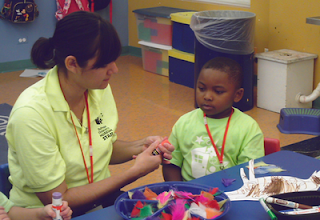First, a short presentation invites discussion related to theories of constructivism, including the work of Jean Piaget and Lev Vygotsky. Common to these theories are real-world experiences with objects and people. Piaget tells us about a series of stages children go though as they learn, each building on milestones that occur in the step prior. Vygotsky helps us understand learning by presenting a zone of proximal development where children learn skills with the guidance of another.
Next, we introduce the students to the Museum’s “Neighborhoods” and how they are developed to support early learning through play. It’s a great way for beginning child development students to explore how theoretical knowledge is put into practice. Engaging children in active learning through play is a key consideration as DCM’s exhibits and programs are produced. Teams of artists, scientists, engineers, mathematicians, educators and other experts have come together to provide an environment rich in materials and resources that reward curiosity, enthusiasm, creativity, experimentation and problem solving.
Finally, it’s time for the students to put their new theoretical knowledge into practice on the Museum floor through stimulating, hands-on experience with the exhibits -- creating their own fun and “learning through play”!















